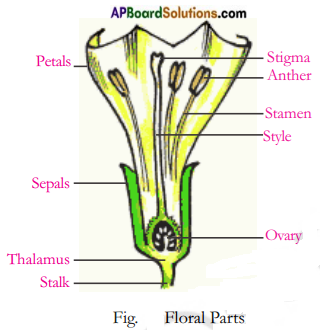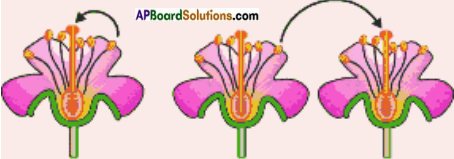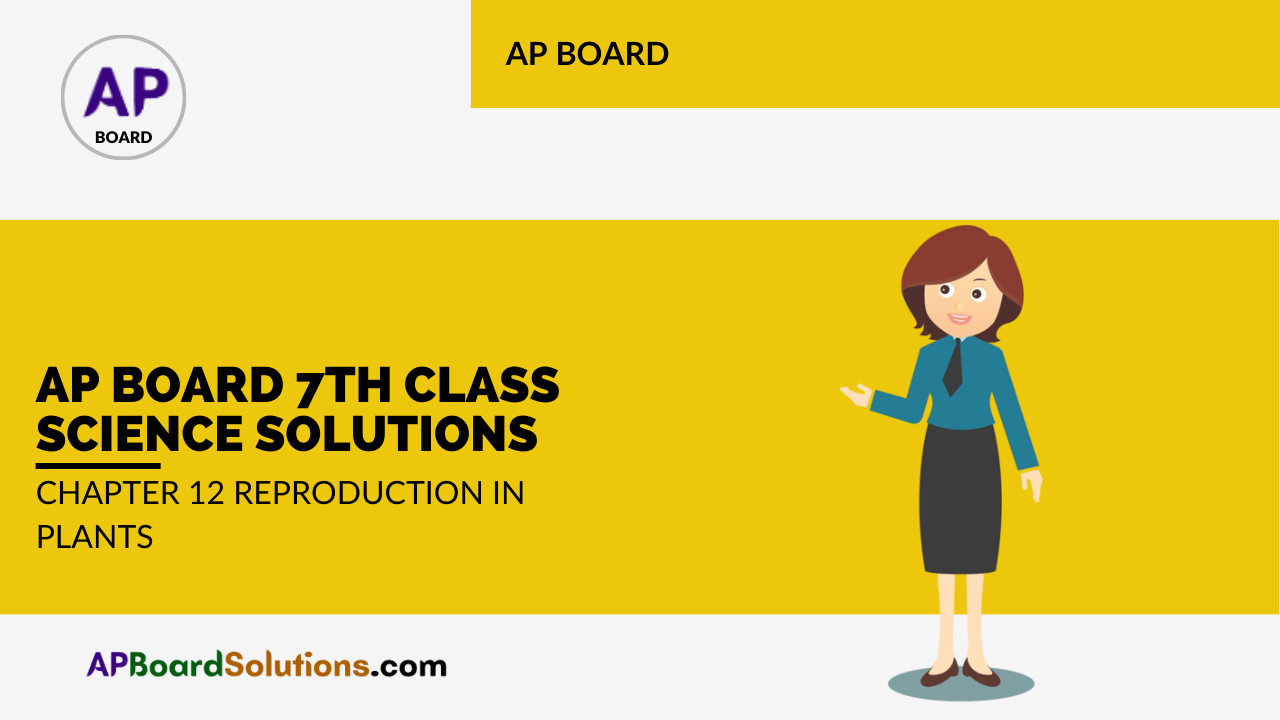AP State Syllabus AP Board 7th Class Science Solutions Chapter 12 Reproduction in Plants Textbook Questions and Answers.
AP State Syllabus 7th Class Science Solutions 12th Lesson Reproduction in Plants
7th Class Science 12th Lesson Reproduction in Plants Textbook Questions and Answers
Improve Your Learning
Question 1.
Do all flowers have same parts? Give examples of some flowers and explain your answer.
Answer:
- All flowers do not have the same parts.
- The stamens are the male reproductive part and the Pistil is the female reproductive part..
- The flowers which contain either only the pistil or only the stamens are called unisexual flowers.
Eg: Corn, papaya, cucumber … etc. - The flowers which contain both stamens and pistil are called bisexual flowers.
Eg: Mustard, rose, petunia …. etc. - A flower that has four or more whorls is called a complete flower.
Eg: Datura, ipomea, Hibiscus … etc. - A flower in which any of these four whorls is missing is an incomplete flower.
Eg: cucumber, bottle gourd, papaya.
![]()
Question 2.
Differentiate between
a. Bisexual flowers, Unisexual flowers.
b. Complete flower, incomplete flower.
c. Male flower, female flower.
d. Sexual reproduction, Asexual Reproduction.
e. Self pollination, Cross pollination.
Answer:
a)
- Bisexual flowers: A flower that has both stamens and pistil is called bisexual flower.
eg: Datura, hibiscus, ipomea etc. - Unisexual flowers: A flower which has either stamens or pistil is called unisexual flower.
eg: Cucumber, bottlegourd, bittergourd etc.
b)
- Complete flowers: A flower that has four or more whorls is called a complete flower.
eg: Datura, ipomea, hibiscus… etc. - Incomplete flowers: A flower which has either stamens or pistil is called unisexual flower.
eg: Cucumber, bottlegourd, bittergourd etc.
c)
- Male flower: The flowers which has stamens (androecium) only are male flowers.
- Female flower: The flowers which has pistil (gynoecium) only are female flowers.
d)
- Sexual reproduction: New plants are obtained from seeds. New individual has characters of both the parents.
- Asexual reproduction: Plants can give rise to new plants without seeds. Characters of the new individual are the same as that of the only parent.
e)
- Self pollination: In self pollination pollen grains of the same flower reaches the stigma. No Agency is required.
- Cross pollination: In cross pollination, the pollen grains of another flower either on same or other plant reaches the stigma. Agencies are required.
Question 3.
What happens when a pollen grain falls on a stigma?
Answer:
- When a pollen grain falls on a stigma the pollen grain germinates and a pollen tube comes out.
- The pollen tube grows and approaches through the style to ovary, carrying male ‘ gametes with it, where it enters the ovule.
- Inside the ovule, there is a female gamete or egg.
- The male gamete fuses with the female gamete.
- This process is called fertilization.
![]()
Question 4.
What helps to bring pollen grains to the stigma?
Answer:
Agencies like water, wind, air, animals, humans and insects help to bring pollen grains to the stigma.
Question 5.
Explain the method of sexual reproduction in plants.
Answer:
Sexual reproduction in plants:
- New plants are obtained from seeds.
- Two parents are required to produced an individual.
- Takes place with the help of specialised sex cells.
- New individual has the characters of both the parents.
Question 6.
Can plants produce new plants even without seeds ? Explain the methods with examples.
Answer:
- Plants can give rise to new plants without seeds.
- The new individual comes from a single parent.
- No sex cells are required.
- Characters of the new individual are same as that of the only parent.
- A potato has a number of small depressions on its surface. These are called eyes.
- Cut the potato into pieces such that there is an eye in each piece, If it is put in a cup containing soil and water we find potato plants sprout.
- We find baby plants on the edge of the leaves of the plant Bryophyllum.
- We grow plants like rose, hibiscus and Jasmine by cutting a small branch and planting them in the soil.
Question 7.
Draw the diagram of any flower showing its parts.
Answer:

Question 8.
Do all plants reproduce in the same way? Explain with examples.
Answer:
- All plants do not reproduce in the same way. Given below the plants and their parts which can reproduce.
- Vegetative reproduction in some plants.
Plant Part of the plant Sweet potato, dahlia, carrot, turnip, radish New plants grow from the modified root. Potato New plants grow from eyes in the tuber which is a modified stem. Onion, garlic, tuberose, lilies, gladioli New plants grow from bulbs, or corms (gladioli), which are modified stems. Bryophyllum (sprout leaf plant), begonia New plants grow from buds on the leaf Sugarcane Stem grows roots, at the nodes Mint, strawberry, chrysanthemum, raspberry Stem creeps along the ground and strikes roots at the nodes.
![]()
Question 9.
Karthik saw a cucumber plant in the kitchen garden. He identified two types of flowers – some flowers had a small swollen structure behind them while some did not. He removed all the flowers which did not have the swollen structure behind them thinking that they were of no use.
- Which flowers did he remove?
- What are the flowers which had a small fruit behind them?
Answer:
- Karthik removed all the male flowers which did not haye swollen structures.
- He felt that these flowers were of no use.
- Female flowers had a small fruit behind them..
Question 10.
What are the agents of pollination?
Answer:
Air, water, animals, insects, humans act as agents of pollination.
Question 11.
Differentiate between self pollination and cross pollination.
Answer:
| Self Pollination | Cross Pollination |
| In self pollination pollen grains of the same flower reaches the stigma. | In cross ppllination, the pollen grain of another flower either on the same or other plant reaches the stigma. |
| No agents are required | Agents like wind, water, animals, insects are required. |
| Occurs only in bisexual flowers | Occurs in unisexual flowers, under monoecious / diecious conditions. |
Question 12.
Name the parts of the following plants from which they propogate vegetatively
a) Potato b) Bryophyllum
Answer:
a) Potato:
- It has a number of small depressions on its surface. These are known as eyes.
- Potato plants sprout through these eyes.
b) Bryophyllum: 1) on the edge of the leaves of Bryophyllum, the plant Bryophyllum reproduces.
![]()
Question 13.
What am I?
a) I am formed by the fusion of male and female parts.
b) I am a part of the plant that can travel a long distance and grow to a baby – plant.
Answer:
a) Zygote is formed by the fusion of male and female parts.
b) Seed.
Question 14.
Fill in the blanks.
a) Flowers containing both male and female parts are called ……….
b) Pollen grain from the anther of one flower that reaches the stigma of another flower is called ……….
c) From ………. part of Bryophyllum new plants are produced.
d) Agents of pollination are ……….
e) Transfer of pollen grain from anther to stigma is called ……….
Answer:
a) Bisexual flowers
b) Cross-Pollination
c) leaves
d) Air, water, animals, insects, humans
e) Pollination
Question 15.
Match the following.

Answer:

![]()
Question 16.
Observe the following figures. What difference do you observe? Write in your notebook.
(OR)
Look at the pitcure ‘a’ and ‘b’. Write the process of pollination seen in both.

Answer:
- Fig a: This figure represents the self – pollination taking place.
- Fig b: This figure represents the cross- pollination taking place.
